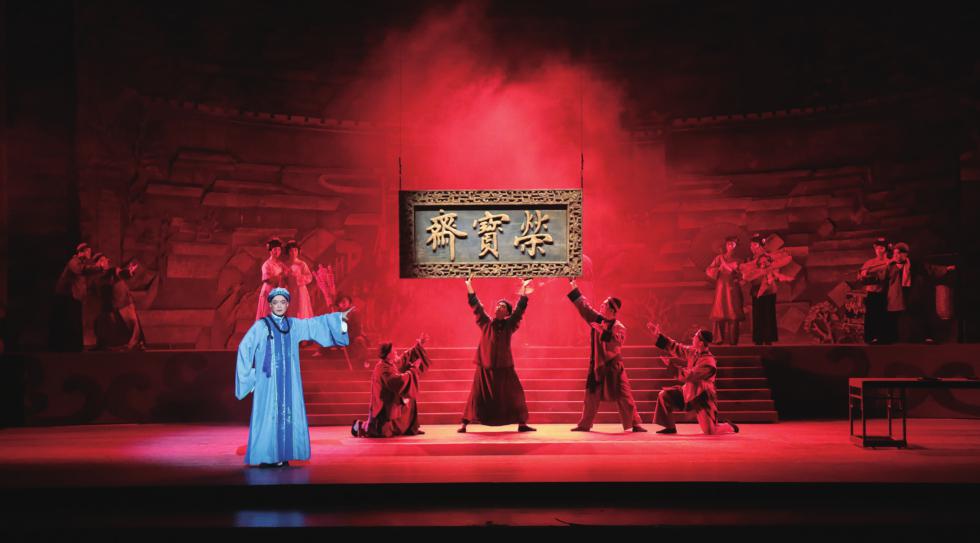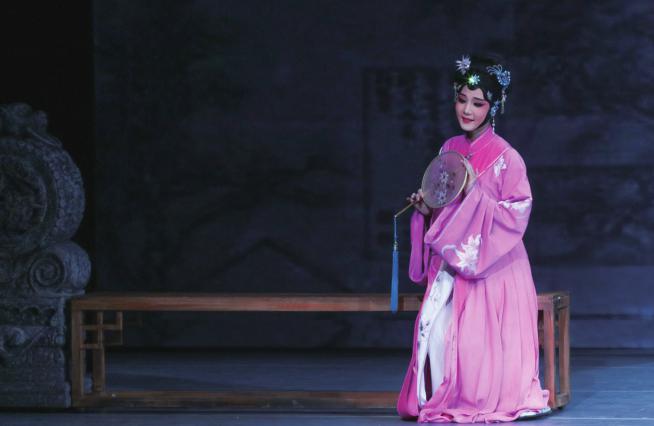A Toned Opera
2018-02-17ByYuanYuan
By Yuan Yuan

Situated along Liulichang Street, a hutong(alleyway) in downtown Beijing chock full of quaint shops selling antiques, calligraphy and painting tools, Rongbaozhai is defi nitely the biggest name among the stores.
Different from many other hutong areas with a hipster dazzle of tourists, this sector is a tranquil retreat from the crowds. With a history of more than 300 years, Rongbaozhai is the oldest store there and peoples fi rst choice for buying painting and writing brushes, ink or paper. The displays and commodities in the store still show a glimpse of a glorious past.
Although the stories behind a few timehonored stores, such as the Tongrentang herb shop and the Quanjude roast duck restaurant, have been adapted to stage dramas and operas many times, the story of Rongbaozhai has remained elusive. That is until December 10, when a Kunqu Opera production adapted from the Rongbaozhai story was set to the stage at the Tianqiao Performing Art Center in Beijing.
No easy task
“Tongrentang and Quanjude are quite close to our daily lives and everybody is quite familiar with them, but Rongbaozhai is considered to be a place only for intellectuals,” Ling Jinyu, director of Rongbaozhai, told Beijing Review.
What ignited Lings imagination was a Peking Opera script featuring Rongbaozhai. Ling really liked it and recommended it to Yang Fengyi, President of the Northern Kunqu Opera Theater (Beikun), who also loved the script and immediately decided to adapt it to Kunqu play.
“Rongbaozhai has strong Beijing characteristics and its only natural for the audience to assume that whoever performs in this play will speak in a Beijing dialect,” Ling said. “But Kunqu Opera is a very different style.”
With a 600-year history, Kunqu, named after its birthplace in Kunshan of east Chinas Jiangsu Province, is famous for its poetic and silky style. In 2001, Kunqu was proclaimed a Masterpiece of the Oral and Intangible Heritage of Humanity by UNESCO. And in 2006, it was placed on Chinas national intangible heritage list.
Compared to Peking Opera, the singing tune of Kunqu is much softer. How to combine the two contrasting styles was the biggest challenge for the crew. “All the advantages of the script turned out to be disadvantages when adapted into Kunqu,” Ling lamented.
It was also a hard nut to crack for the lyric writer Han Feng, who had never experimented with a Kunqu creation before and had to spend several months learning the Kunqu melody.
“Unlike a Peking Opera, where lyric writers have much more freedom, the lyrics in Kunqu have to fi t into several fi xed tunes, called qupai, where the number of characters in each sentence is fi xed and has to rhyme,” Ling explained.
Due to the diffi culty of Kunqu writing, which demands a high level of literary knowledge, Ling said that there are less than 10 Kunqu lyric writers in China today.
As Han struggled with the writing of the play, the rest of the crew spent months at Rongbaozhai, learning its history and figuring out the best way to tell its story. Han fi nally fi nished the script this past summer.
The woodblock watercolor printing technique—the master Rongbaozhai technique—was set as the highlight of the play. A unique technique to reproduce calligraphy and paintings, it dates back over 1,000 years and was revived in the early 20th century.
“This play is a perfect combination of two heritages,” Ling said. The plot is based on Yin Jie, head of Rongbaozhai during the late Qing Dynasty (1644-1911), and his efforts to protect its national treasures and revive the woodblock watercolor painting technique.
To lessen the effect of the Beijing dialect in the play, standard Mandarin is spoken by most of the characters, with the exception of a few. And although they are similar, audiences are able to distinguish between the two.
Notwithstanding the long preparation for the opera, which spanned almost a year because many leading players had other performances, the time for rehearsal was quite limited. “In total, we only had about a month for rehearsal,” Ling said. “But the result is very satisfying. I think with more performances in Beijing and other places in China, this will become another classic production for Beikun.”
A wider audience
Kunqu has gained much more popularity in recent years and Beikun, the only Kunqu troupe north of the Yangtze River, is getting more acknowledgment due to staff efforts, especially Yangs.
Hailed as the mother of all Chinese operas, Kunqu is regarded as the oldest type of musical drama in China as many other operas have borrowed from or modeled themselves after it. But it is also tagged as “an art of elegance,” keeping it away from a wider audience.
Even as its influence waned over the past centuries, it remained the standard-bearer for Chinese theater arts, with an unparalleled refi nement of libretto, melody and choreography, along with the subtle sentiments they convey.
When Yang took the presidency of Beikun in 2009, the situation was not optimistic. The audience numbered less than the players on the stage, making Yang very anxious. Since Kunqu originated in south China, audiences in the north tend to be smaller. Some Beikun performers even had to pursue other jobs to earn extra money as the pay was very low.
But in recent years, the situation has changed for this traditional art form with the Central Government helping to keep Kunqu alive through fi nancial support and the training of young talent. Some retired Kunqu performers have also returned to theaters in recent years to teach young students.
Currently, Beikun has nearly 100 performers and the majority of them are young. In 2017, the theater offered 234 shows across the country that attracted more than 190,000 people, mostly young students and white-collar workers, according to Yang.
Along with original creations, the theater also stages traditional Kunqu repertoires. In February, the theater premiered its 140-minute production, Orphan of the House of Zhao, known as Chinas Hamlet, about an orphans revenge against those who killed his family members when he was an infant. It was the fi rst time it was adapted into Kunqu, marking the theaters efforts to develop and reach out to a wider audience.
A new venue under construction at the original location of the theater is scheduled to open in 2019. It will not only serve as a platform for artists, but will also be a place where the public can learn more about Kunqu.
“To revive Kunqu, we need innovative thinking. But innovation is in no way subversion to tradition. We are working to find a balance between the two,” Yang said.
Beikun is also planning an opera based on the painting Along the River During the Qingming Festival next year. “We hope to convey more genuine Chinese stories to more international audiences through the art of Kunqu,” Yang said.
